
ARCHIVED PAGE - PLEASE READ!
This page was written by me a long, long time ago. As such the quality of the writing, photography and/or any conclusions I may have come to simply do not stand up to the levels I consider necessary these days.
I do not believe in deleting things outright though as I feel that these pages form something of a time capsule from an earlier stage in my life, and may still be of some interest to folks who have been coming here for a long time. So instead of deleting this page it has been archived.
PLEASE NOTE THAT THIS PAGE HAS BEEN ARCHIVED, AND SHOULD BE CONSIDERED "FOR INTEREST ONLY" AND NOT BE USED FOR ANY OTHER PURPOSE. LINKS, PRICING ETC ARE LIKELY TO BE OUTDATED AND WILL NOT BE UPDATED.

Princeton Tec Impact II. Rating: 80%

The Impact 2 is the AAA based little brother of Princeton Tec's popular Impact flashlight. Featuring a single 5mm LED, an almost unique optical system, an impressive 500 foot water resistance rating, and a tough polycarbonate body. In the translucent neon yellow colour however, it's a PAIN to photograph!
Product Info:
Manufacturer: Princeton Tec.
Available from: N/A - Obsolete product.
Price (Correct at time of writing): US $23.95 (~£13.50).
Size: 12.6cm x 2.7cm.
Number of lamps: 1.
Lamp Type: Standard 5mm LED.
Lamp Current: Unknown (Unable to measure).
Lamp Colour: White.
Body finishes available: (translucent) Yellow, Red, Blue, Black.
Battery type: 4 AAA Alkaline. (Supplied).
Switch Type: Twist Bezel. No intermittent option.
Water Resistance: Water resistant, submersible to 500 feet (claimed).
Approximate Beam angle: ~5 Degrees.
Camera light meter reading at 30cm: 262.
Notes: Light comes supplied with Duracell Alkaline batteries and a split ring to allow attachment to a lanyard.
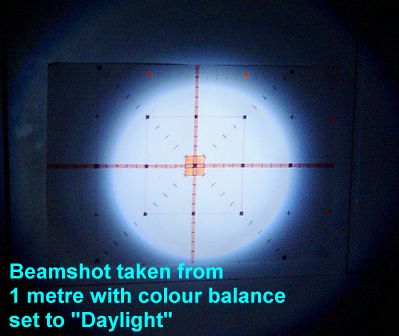

Packing:
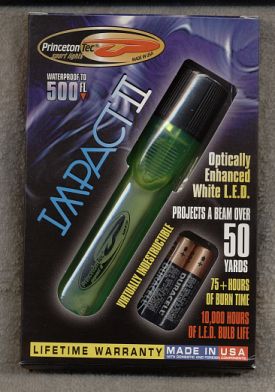
The Impact II comes in a professional looking card box with a plastic insert. The rear of the box gives a bit of information about the light, including a handy little specification list as is shown in the picture to the left. The light itself is clearly displayed in its packaging, allowing you to see what colour it is, as there are a variety of body colours available.
Getting into the packaging is not difficult - but maybe isn't as simple as it could be. The first thing I tried to do was open it from the top - it occurred to me though, that there was no way I was going to get in from there without ripping the lid, as there's a plastic hanging loop there to allow the light to hang from a retail rack. Turning the box around, and opening the bottom of the box, and sliding the insert out allows you both to gain access to the goods inside the box, and keep it intact - which for a reviewer, is kinda important. Included in the packaging is the light itself, a set of Duracell batteries, a split ring, and a couple of leaflets detailing both the warranty and the rest of Princeton Tec's current range of flashlights.
The plastic insert holds everything where it's meant to be, and is held closed by large plastic "poppers" which simply pull apart. No need for any fancy tools (destructive or otherwise), or explosives for this one.
Full size Packing pics: Front Rear
Power Source:
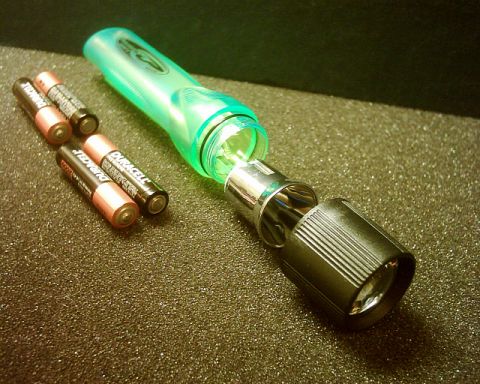
Thanks to some clever design work on the part of PT, 4AAA batteries have been crammed into a light that's the sort of size you associate with 2 cell lights.
This is accomplished by the use of a side-by-side battery configuration, having the four cells in series, but in two rows of two. This allows the light to be uncommonly small, which was the first thing I noticed when I got it, I had expected this light to be quite considerably larger!
The packaging claims that the light will run for 75+ hours on a set of batteries, I can see no signs of a regulation circuit in this light though - so that will be 75 hours of gradually dimming light. Whether or not it achieves the 75 hours it claims, I do not yet have the information on hand to prove.
Changing the batteries ain't complicated though, when it eventually does need to be done.
Firstly, unscrew the black bezel until it comes off, best have the light facing upward when you do this, so that things don't go rolling everywhere.
Carefully remove the LED and reflector module and set it aside.
Dump the dead batteries out and dispose of them properly.
Now, this bit is a little odd. Insert two new cells into one side of the body + end first, and two in the other side - end first. Which way around these are doesn't matter - why is explained in the next step.
Look at the bottom of the LED module, you'll see two contacts - these have a positive and a negative marking next to them, place this module back into the barrel of the light so that these markings line up with the positive and negative terminals of the batteries. If you manage to get it wrong, and the light doesn't work - take it out and rotate it through 180 degrees, and everything should now work.
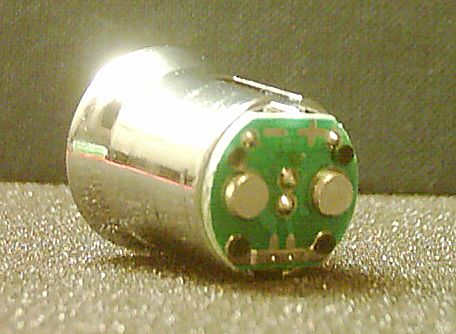
Finally, screw the black bezel back on - be careful not to cross thread it of course, and back it off a little once your Impact II lights.
So long as you don't lose the LED module (this would be a bad thing to do...), there's nothing too complicated here.
Lamps:

The light source in the Impact II is a pretty conventional 5mm white LED, this is mounted at the bottom of a moderately deep reflector, this reflector actually does relatively little as the LED emits very little light to the sides anyway. However, the main interesting feature here is the optical arrangement. There is a very high quality magnifying lens moulded into the bezel. This lens is actually of a high enough quality that I was able to use it as an ultra-close-up lens for my digital camera, I shall upload some of the results here soon.
This lens in conjunction with the lens moulded into the LED casing itself produces a very narrow highly collimated beam with an extremely sharp cutoff at the edge of the hotspot. The reflector appears to provide the rather weak (but useful) side spill. The beam is very much like that of an Inova X1 flashlight, but with at least a little side spill, making a much more user friendly beam in my opinion.
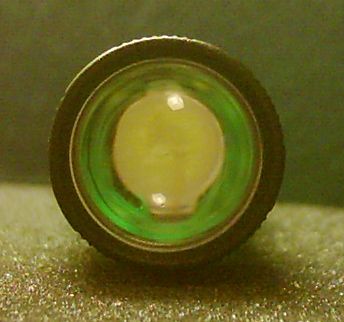
The other result of this, is that it looks just plain weird if you look into the bezel when the light is turned off, as the image to the right shows. That IS actually a highly magnified image of the LED's die cup and the surface of the LED phosphor.
Phosphor? I hear you say. Let me explain. A white LED isn't actually a white LED at all. It's a blue LED in disguise. What you have is a blue LED die (the bit that glows), which is covered with a phosphor. This phosphor glows yellow when exposed to blue light. When you get the right mix between the blue from the LED and the yellow from the phosphor - you get white.
The main advantage of LED's is clearly that they are very long-lived compared to incandescent light bulbs, with a rated lifetime of some 10'000 hours in this case (to put this in perspective - a compact fluorescent light bulb generally has a rated lifetime of between 12'000 and 15'000 hours). In a flashlight, this is a VERY long time. This is further helped by the fact that LED's are pretty much impervious to vibration and shock. In something like a flashlight which is likely to get dropped or just generally bashed around, this is an important point. In theory, LED's can last to around 100'000 hours - this however is counting on a lot of things; most notably, the LED not being driven too hard, being kept cool, and being fed nicely regulated power without any voltage spikes or anything. In a flashlight, it's hardly unknown to see LED's being driven at up to 50mA (rated to 30), and still having that 100K hour figure thrown around. While at 50mA, those LED's are going to be getting HOT, and will probably not last more than a couple of 100 hours. I expect that the LED in the Impact II is overdriven a bit (but not much), so it's refreshing to see a manufacturer who's being a bit more honest by quoting 10K hours rather than 100K.
The main killer of LED's in flashlights is manufacturers overdriving them (feeding them too much current causing them to overheat). I haven't yet figured out a way to measure the current consumption of this light yet, so I can't comment on whether this LED is overdriven or not, probably is a bit though. Due to the construction of this light, it'll be near impossible to get a current reading..
Operation:
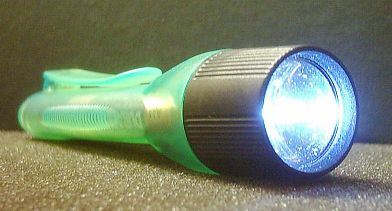
The Impact II is about as simple as they get in terms of operation. There's a simple on/off control, that's it. No multiple modes, no focus to mess around with. Just twist the black bezel as if tightening it to turn it on, and loosen it a little again to turn it off. Simple.
(And no, the specs on the lens don't come as standard, those are dust specs which have attached themselves to the light in the few hours it's been out of the packaging!)
Ergonomics:
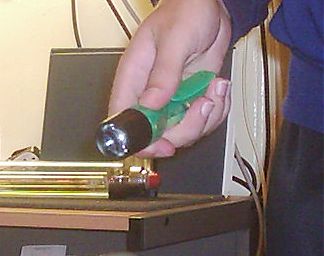
Thanks to the pretty unusual 2+2 battery layout, this light fares well in this area. The flat shape fits beautifully in the hand, and inherently acts as an anti-roll device. The image to the left shows how the light fits into the hand - and just how small this thing is!
(And yes, that is a 35W Osram SOX low pressure sodium lamp on the desk in the background - I collect them as well).
There are ribbed portions on both the "sides" of the light, around the bezel and on the depressions which are perfectly placed for you thumb and finger to rest on when you're holding it. These ribbed portions aid both in holding onto the light when you've got cold, greasy, wet of sweaty hands, and in turning the bezel to switch the light on or off, as it can be quite stiff to turn.

That is my only potential grumble on this topic, is that the bezel - even when the O-ring is properly lubricated, is a little hard to turn with one hand. Theoretically, you could remove the O-ring, making it easier to turn. However, that would come at the expense of the water resistance, and would make the light more prone to switching on/off unintentionally.
Performance:
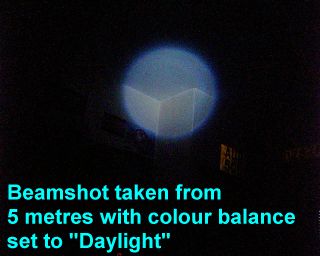
For a single LED light, this little thing has a surprising amount of punch. This is partly down to the use of the optics in the bezel. These allow the same overall amount of light to throw far, far further than it would normally with the LED alone. This does however come at the expense of spill light. The net result of this, is that walking around with this light at night can tend to lead to "tunnel vision" to an extent, as the spill is very, very weak (Less so than with the Inova X1, which has NO side spill whatsoever). It's a usable light, and a darn good thing for picking things on the far side of the room out without lighting the entire area up, but isn't the perfect light for walking around with or reading. It's a spotlight, not a flood light.
If you're looking for a 5mm LED light with a bit more throw than usual, this one's a good bet. Though a better analogy would be an Inova X1 with a bit more side spill. The light's also a little brighter overall than the X1 I think, but without my X1 to check by, I can't be sure of that.
Durability Department:
When you first take the Impact II out of the box, you might not be frightfully impressed with the feel of it. It feels pretty much exactly the same as those £1 plastic lights that you see zillions of in every town market and corner shop. When you put the batteries in, things improve a little, but it still doesn't feel exactly indestructible.
However, this is a case where that feeling doesn't tell you quite the truth. This may be light plastic - but it isn't the cheap brittle plastic the aforementioned lights are made of. This sucker's polycarbonate. At least the body is, I'm not so sure about the head, but it seems plenty solid enough, so I'm guessing it is as well. Dropping it and throwing it around the room (with a little more than slight force in a couple of cases) didn't so much as phase it. If dropped on concrete or something strongly abrasive, it might pick up some scratches, but that won't affect the operation. Standing on, sitting on dropping out of your pocket when you're fixing the roof aren't going to bother it. This is a durable light all right. Just don't go out of your way to scratch the lens anyway. I'm pretty sure that if you managed that, that PT would send you a new bezel for a small price if you asked nicely anyway.
The main real weakness is the pocket clip. It's moulded into the body of the light, and I have heard reports of it snapping off. So if I were you, I'd use that clip sparingly, there is a lanyard attachment point - use it.
As for water resistance - I really didn't expect my bathtub test to phase it, given that it's claimed to be waterproof to 500 feet below sea level...needless to say, it remained totally dry inside when left at 1.5 feet underwater in my bathtub for an hour. No need to worry about getting this one wet.
Just remember to occasionally lubricate the O-ring with silicone grease, and that water resistance should remain intact.
I noticed a slight rattle from my unit when I first got it, yours will most likely do this as well. It's simply a platinum catalyst pellet inside the LED module, and should be ignored. This pellet is there to absorb any gases that the batteries may emit during the course or normal use, as the light is a sealed vessel, and this could otherwise present a risk of gas build up inside the light.
So long as you avoid running this light over with a jeep, throwing it in the furnace or attacking it with a hacksaw, I doubt you'll hurt it. Don't go out of your way to smash the LED module when changing the batteries either. This is a tough little light.
Overall:
I think one word sums this thing up: Dependable.
There are brighter lights out there, there are cheaper lights out there. However, this one's pretty bright for what it is, runs for a good long time on a set of batteries, and runs on readily available batteries. And it's tough. You know when you pick it up, that it's always going to work. The narrow beam might not be to everyone's taste, but other than that, there's little to complain about.
Pros:
+Bright for a single LED light.
+Has more throw than most 5mm LED lights.
+No bulbs to burn out.
+Easy to use.
+Durable.
+Feels good in the hand.
+Uses cheap and common batteries.
+Good battery life.
Cons:
-Narrow beam isn't the best for general use.
-Not regulated.
Niggles:
>Cannot be stood on tail to light a room by shining on the ceiling. (Some people hate that, I don't care either way myself).
>It's bright for a single 5mm LED based light. Yes. But there are brighter things out there.
>Pocket clip is a little prone to breaking off, but that goes for all using a design like this really.
Ratings:
Beam Quality: 7
Build Quality: 8
Battery Life: 9
Durability: 9
Value: 7
Overall: 40 / 50 = 80%
Long Term Testing:
21st August 2004. Review uploaded. Any updates will be posted here.
3rd August 2009: Page fixed on the new server. Light was packed away in May 2009 when I moved (lack of space!), was working perfectly when packed away.
5th January 2021: Page retired and moved to Site Archive.
28th April 2023: Revised Statcounter code to allow for HTTPS operation.